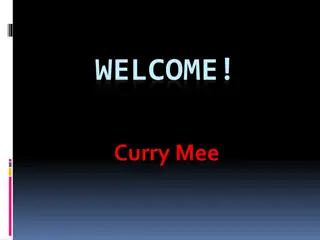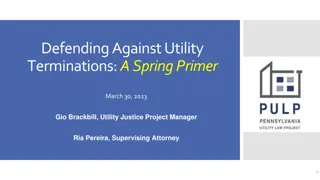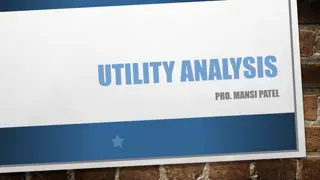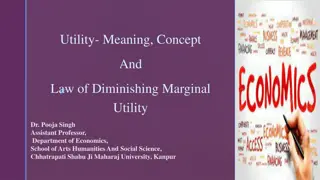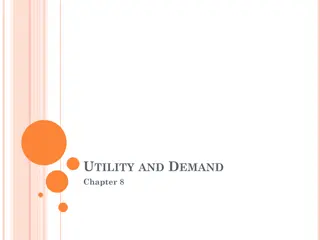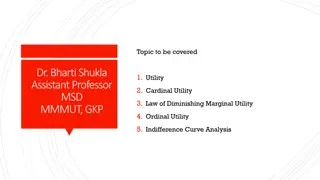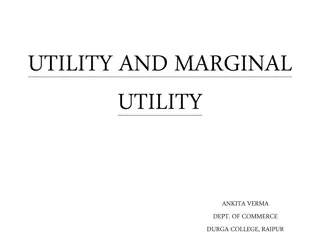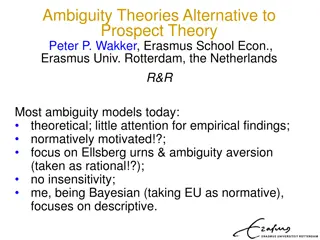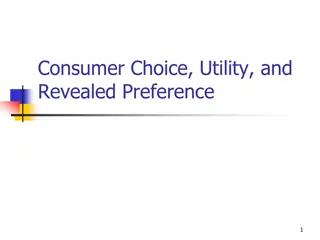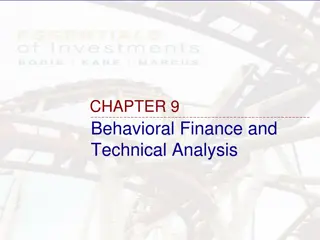Understanding Expected-Utility Theory and Prospect Theory in Finance
Explores the concepts of experienced happiness and life evaluation through Expected-Utility Theory and Prospect Theory. Discusses how individuals perceive wealth changes differently based on these theories, impacting their emotional well-being and overall life satisfaction. Delve into the distinctions between fleeting experienced happiness and sustained life evaluation, shedding light on why income affects these aspects differently.
Download Presentation

Please find below an Image/Link to download the presentation.
The content on the website is provided AS IS for your information and personal use only. It may not be sold, licensed, or shared on other websites without obtaining consent from the author. Download presentation by click this link. If you encounter any issues during the download, it is possible that the publisher has removed the file from their server.
E N D
Presentation Transcript
Finance for Normal People Chapter 6: Experienced happiness, life-evaluation, and choices: Expected-Utility Theory and Prospect Theory
Expected-Utility Theory and Prospect Theory Think of Margaret and Ann Margaret s wealth decreased from $4 million to $3 million yesterday, while Ann s wealth increased from $1 million to $1.5 million Who experiences greater happiness today? And who reports higher life-evaluation?
Expected-Utility Theory and Prospect Theory Two concepts of happiness: experienced happiness life-evaluation Experienced happiness is also called emotional well-being and hedonic well-being
Expected-Utility Theory and Prospect Theory Experienced happiness is assessed by answers to questions about yesterday s experiences, such as yesterday s enjoyment, affection, sadness, or anger Life-evaluation is assessed by Cantril s Self-Anchoring Scale, where people place themselves on a ladder whose rungs go from the bottom worst possible life to the top best possible life Experienced happiness is fleeting happiness Life-evaluation is sustained happiness
Experienced-happiness stops increasing at $75,000 of annual income Life-evaluation does not stop increasing as income increases How is experienced-happiness different from life-evaluation? Chart Title Life-Evaluation Experienced-Happiness $75,000 250000 Annual Income 0 50000 100000 150000 200000 300000
Expected-Utility Theory and Prospect Theory The experienced-happiness of Ann is likely greater than Margaret s because Ann gained yesterday while Margaret lost Ann experiences happiness and pride Margaret experiences sadness and regret But the life evaluation of Margaret is likely greater than Ann s because Margaret s wealth is $3 million, exceeding Ann s $1.5 million
Expected-Utility Theory and Prospect Theory Expected-utility theory and prospect theory are two theories that assess happiness and predict choices A comprehensive theory that assesses happiness and predicts choices combines expected-utility theory and prospect theory and goes beyond them
Expected-Utility Theory and Prospect Theory Utility in expected-utility theory is wealth-utility -- life-evaluation or sustained happiness derived from wealth One prediction of expected-utility theory is that sustained happiness from wealth is high when wealth is high, placing the wealthy higher on the life-evaluation ladder
Figure 6 Figure 6- -1: Wealth and wealth 1: Wealth and wealth- -utility in expected utility in expected- -utility theory utility theory Units of Wealth- Utility 2700 2580 2200 1830 aaaa 1450 $1.5M $1M $2M $3M Wealth
Expected-Utility Theory and Prospect Theory Utility in prospect theory is gain-loss-utility -- experienced-happiness or fleeting happiness derived from gains and losses of wealth relative to a reference point Levels of wealth yesterday, such as Margaret s $4 million and Ann s $1 million, are likely reference points
Figure 6-2: Gains and losses and Gain-Loss Utility in prospect theory Units of Gain-Loss Utility 72 -$1M $0.5M Losses Gains -188
Expected-Utility Theory and Prospect Theory Expected-utility theory predicts that people are not confused by the frame of wealth Prospect theory predicts that people are regularly confused A frame that comes easily to the minds of Elizabeth and Ann is prospect theory s frame of gains and losses relative to yesterday s wealth as the reference point -- Ann gained whereas Margaret lost How can a friend of Margaret change her frame to cheer her up?
Expected-Utility Theory and Prospect Theory Both expected-utility theory and prospect theory offer predictions about choices Both theories also predict that choices reflect risk-aversion, but definitions of risk by the two theories differ
Expected-Utility Theory and Prospect Theory Variance-aversion and loss-aversion Expected-utility theory predicts that all choices reflect risk-aversion Never risk-seeking where risk is measured by the variance of returns Prospect theory also predicts that all choices reflect risk-aversion -- where can be variance-aversion, loss-aversion, or shortfall-aversion
Expected-Utility Theory and Prospect Theory Choices when all outcomes are in the domain-of-gains Choose between: A. a sure $10,000 B. a 50-50 gamble for $20,000 or $0
Figure 6-3: Choices by expected-utility theory when gamble outcomes cannot reduce total wealth Units of Wealth-Utility 270 258 220 145 $30,000 $10,000 $20,000 Wealth
Figure 6-4: Choices by prospect theory when outcomes are all in the domain of gains Units of Gain-Loss Utility 137 110 0 $10,000 $20,000 Losses Gains
Expected-Utility Theory and Prospect Theory Choices when some outcomes are in the domain-of-losses Loss aversion Choose between: A. a sure $0 B. a 50-50 gamble for a $20,000 gain or a $5,000 loss
Figure 6-5: Choices by expected-utility theory when some outcomes can reduce total wealth Units of Wealth- Utility 270 258 220 185 145 $10,000 $30,000 $20,000 $15,000 Wealth
Figure 6-6: Choices by prospect theory when some outcomes are in the domain-of-losses Units of Gain-Loss Utility 137 110 -$5,000 $20,000 $10,000 Losses Gains -150
Figure 6-7: Choices of people who vary in loss-aversion Units of Gain-Loss Utility 137 110 -$5,000 $10,000 $20,000 Losses Gains -120 Low loss- aversion -150 Medium loss- aversion -195 High loss-aversion
Expected-Utility Theory and Prospect Theory Questions Suppose that you are given an opportunity to replace your current investment portfolio with a new one The new portfolio has a 50-50 chance for a 50% gain in your lifetime standard of living Yet the new portfolio also has a 50-50 chance for an X % loss in your lifetime standard of living What is the maximum X% loss in lifetime standard of living you are willing to accept for a 50-50 chance to gain 50% in lifetime standard of living?
Figure 6-8: Loss-aversion of men and women in China, U.K., U.S., and Vietnam 4.93 4.33 3.81 3.66 3.27 3.11 2.87 2.77 Women Men Women Women Men Women Men Men China United Kingdom United States Vietnam
Expected-Utility Theory and Prospect Theory Shortfall-aversion Shortfall-aversion differs from loss-aversion, although the two are often confused The reference point in loss-aversion is our current position In contrast, the reference point in shortfall-aversion is an aspiration level higher than our current position
Expected-Utility Theory and Prospect Theory Shortfall-aversion Choose between: A. a sure $5,000 loss B. a 50-50 gamble for a $15,000 loss or a $0 loss
Figure 6-9: Shortfall-aversion in prospect theory Units of Gain-Loss Utility -$15,000 -$5,000 Losses Gains -150 -205
Expected-Utility Theory and Prospect Theory Shortfall-Aversion Racetrack bettors to bet on long-shots towards the end of the day Marathon runners strive to finish races by aspired time, such as 4 hours What other examples of shortfall-aversion can you identify?
Expected-Utility Theory and Prospect Theory The role of aspirations in risk taking is central in Milton Friedman and Leonard Savage s observation: Men will and do take great risks to distinguish themselves even when they know what the risks are They introduced a utility function where people derive utility from levels of wealth and are variance-averse, as in expected-utility theory, except for a particular region of wealth where they are variance-seeking shortfall-averse - as they seek to distinguish themselves by reaching their aspirations
Expected-Utility Theory and Prospect Theory Harry Markowitz modified this depiction, centering the region of wealth where people are variance-seeking on their current wealth and arguing that people consider gains and losses relative to their current wealth as they make choices
Expected-Utility Theory and Prospect Theory Daniel Kahneman and Amos Tversky built on the insights of Friedman and Savage and Markowitz in prospect theory where utility is determined by gains and losses of wealth relative to reference wealth That reference wealth of people might be current wealth, but might also be their aspired wealth
Expected-Utility Theory and Prospect Theory Probability weights, aspirations, and expressive and emotional costs and benefits Expected-utility theory predicts that people use objective probabilities of possible outcomes as they consider choices, whereas prospect theory predicts that people use subjective probabilities that can depart from objective probabilities Probability weights are ratios of subjective probabilities to objective probabilities Objective probability indicates a 1-in-1,000,000 chance to win the lottery, but a 100,000 probability weight overweighs this objective probability to a subjective probability to a 1-in-10 chance
Expected-Utility Theory and Prospect Theory In the movie Dumb and Dumber, a man who desperately aspires to attract a woman responds when she says that his chances are not good: https://www.youtube.com/watch?v=KX5jNnDMfxA
Expected-Utility Theory and Prospect Theory Think of a $20 lottery ticket that offers an objective 0.001% probability to win a $1 million prize The expected payoff of the ticket is $10, the product of the 0.001% objective probability and the $1 million prize Does expected-utility theory predicts that we are willing to buy the ticket? Does prospect theory predicts that we are willing to buy the ticket?
Expected-Utility Theory and Prospect Theory Daniel Kahneman described a fourfold pattern where probability weights reflect gaps between objective and subjective probabilities
Emotional benefits of hope of winning a large amount Emotional costs of fear of losing a large amount Question: Pay $20 for a ticket to a $1 million lottery? Question: Pay $2,000 to insure a $1 million house? Objective probability of winning = 0.001% Subjective probability of winning = 10% Probability weight = 10,000 Choice: We buy the lottery ticket Objective probability of fire = 0.1% Subjective probability of fire = 1% Probability weight = 10 Choice: We buy insurance Emotional costs of anticipated regret of foregoing a sure gain of a large amount Emotional benefits of hope of avoiding a sure loss of a large amount Question: Accept $700,000 as settlement or proceed to trial Question: Pay $700,000 as settlement or proceed to trial with a 95% probability of receiving $1 million? with a 95% probability of paying $1 million? Objective probability of receiving zero in trial = 5% Objective probability of paying zero in trial = 5% Subjective probability of receiving zero in trial = 40% Subjective probability of paying zero in trial = 40% Probability weight = 8 Decision: We accept the settlement Probability weight = 8 Decision: We proceed to trial
Emotional benefits of hope of winning a large amount Question: Pay $20 for a ticket to a $1 million lottery? Objective probability of winning = 0.001% Subjective probability of winning = 10% Probability weight = 10,000 Choice: We buy the lottery ticket
Emotional costs of fear of losing a large amount Question: Pay $2,000 to insure a $1 million house? Objective probability of fire = 0.1% Subjective probability of fire = 1% Probability weight weight = 10 Choice: We buy insurance
Emotional costs of anticipated regret of foregoing a sure gain of a large amount Question: Accept $700,000 as settlement or proceed to trial with a 95% probability of receiving $1 million? Objective probability of receiving zero in trial = 5% Subjective probability of receiving zero in trial = 40% Probability weight = 8 Decision: We accept the settlement
Emotional benefits of hope of avoiding a sure loss of a large amount Question: Pay $700,000 as settlement or proceed to trial with a 95% probability of paying $1 million? Objective probability of paying zero in trial = 5% Subjective probability of paying zero in trial = 40% Probability weight = 8 Decision: We proceed to trial
Expected-Utility Theory and Prospect Theory Choose between: A. a sure $50 in cash B. a sure opportunity to meet and kiss your favorite movie star Choose between: A. a lottery offering a 1% chance to win $50 B. a lottery offering a 1% chance of an opportunity to meet and kiss the star
Expected-Utility Theory and Prospect Theory A kiss may have a cash equivalent of less than $50 But a kiss is much more emotionally evocative than the cash
Expected-Utility Theory and Prospect Theory Choose between: A. Pay $20 cash B. a sure, short, painful, but not dangerous electric shock How much would you pay to avoid a 1% chance of an electric shock? How much would you pay to avoid a 1% chance of $20 payment?
Expected-Utility Theory and Prospect Theory Conclusion Attempts to capture in a graph all the factors that underlie people s happiness - utility - and predict people s choices are bound to fail Placing Expected-Utility Theory and Prospect Theory side by side highlights differences in notions of risk and risk-aversion, whether variance-aversion, loss-aversion, or shortfall-aversion, and the tensions among these notions







